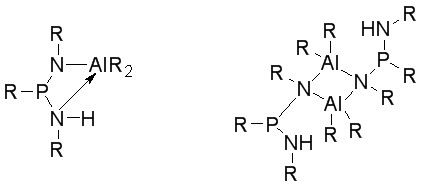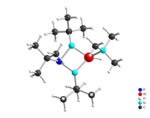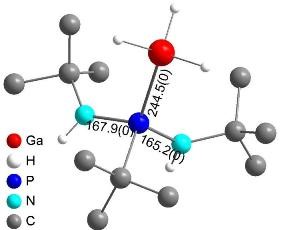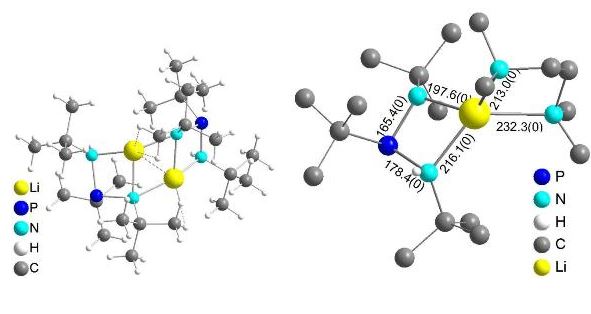Reactions of alkyl-bis(alkylamino)phosphines
Reactions of alkyl-bis(alkylamino)phosphines
The reaction behavior of alkyl-bis(alkylamino)phosphines RP(NHR')2 with organoaluminium compounds was studied representatively with t-BuP[N(H)t-Bu]2. The reaction with one or two equivalents Me3Al leads in each case under methane elimination to the mono substituted product. Reactions with dialkylalanes R2AlH (R = Me, Et, i-Bu) [1] proceeded in an analogous fashion.

Figure 1: Reactions of alkyl-bis(alkylamino)phosphinesRP(NHR')2 with organoaluminium compounds
Unfortunately, the molecular structure of the resulting compounds could not be determined. In addition to an intramolecular stabilization by coordination of the second amine fragment ,the compounds can be intermolecular stabilized by the formation of an Al2N2-ring.

Figure 2: Intramolecular vs. intermolecular stabilization of the phosphinoalane
Results of the reaction of t-BuP(N(H)t-Bu)2 with AlH3(NMe3) suggest that the intramolecular stabilization is preferred. In this case, [t-BuP(NHt-Bu)N(t-Bu)AlH2]2 [2] is formed by H2-elimination, which reacts after a second H2-elimination to the first neutral diazaphosphaaluminatedine, t-BuP(Nt-Bu)2AlH(NMe3),[3].

Figure 3: Molecular structures of [t-BuP(NHt-Bu)N(t-Bu)AlH2]2 and t-BuP(Nt-Bu)2AlH(NMe3)
In contrast, boranes, gallanes and indanes MR3 (M = B, Ga, In) were found to react at the "soft" P-center with formation of the corresponding phosphine adducts t-Bu(NHt-Bu)2P─MR3 (MR3 = BH3, GaH3, GaMe3, InMe3) [2].

Figure 4: Molecular structure of t-Bu(NHt-Bu)2P─GaH3
The reaction of t-BuP(N(H)t-Bu)2 with n-BuLi proceeds with deprotonation and formation of the Li-amidophosphines [t-BuP(NHt-Bu)N(t-Bu)Li]2, which exists in the solid state as a dimer.
By reaction with tetramethylethylenediamine (tmeda), it is converted into the monomeric form of t-BuP(NHt-Bu)N(t-Bu)Li(tmeda) [2].

Figure 5: Molecular structures of [t-BuP(NHt-Bu)N(t-Bu)Li]2 and t-BuP(NHt-Bu)N(t-Bu)Li(tmeda)
References
[1] T. Bauer, S. Schulz, M. Nieger, Z. Anorg. Allg. Chem. 2001, 627, 266-270.
[2] T. Bauer, S. Schulz, M. Nieger, U. Keßler Organometallics 2003, 22, 3134.
[3] S. Schulz, T. Bauer, M. Nieger J. Chem. Soc. Chem. Commun. 1999, 879.
